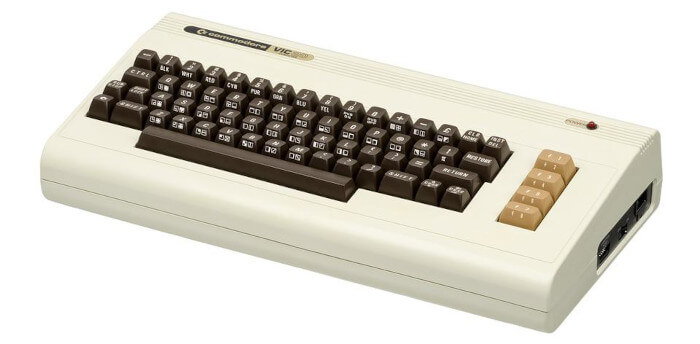Emulation is the practice of using a program (called an emulator) on a PC to mimic the behaviour of a home computer or a video game console, in order to play (usually retro) games on a computer.
Home computers were a class of microcomputers that entered the market in 1977 and became common during the 1980s. They were marketed to consumers as affordable and accessible computers that, for the first time, were intended for the use of a single non-technical user.
Back in the 1980s, home computers came to the forefront of teenagers’ minds. Specifically, the Amiga, ZX Spectrum, and Atari ST were extremely popular. They were hugely popular home computers targeted heavily towards games, but they also ran other types of software.
The Commodore VIC-20 is an 8-bit home computer that was released in 1980/1. It featured a MOS Technology 6502 CPU, with 20KB ROM and 5KB RAM although 1.5K of the RAM was used for the video display and aspects of the BASIC and kernal.
It offered limited low-resolution graphics (176 x 184) with storage provided by cassette and floppy disk.
VIC-20 ROMs
There are 3 ROMs required to use emulators like VICE. You’ll need the kernal, basic, and chargen. These are copyrighted by, it appears, Tulip Computers who are based in the Netherlands.
The kernal (8K) consists of the low-level, close-to-the-hardware OS routines roughly equivalent to the BIOS in IBM PC compatibles. The basic file is the BASIC ROM which is also 8K. The chargen is the character generator ROM which is 4K in size.
VIC-20 Emulators

VICE (Versatile Commodore Emulator) is our recommended VIC-20 emulator.
VICE offers faithful emulation.
The software emulates all the internal hardware, including the VIA chips. The VIC-I video chip is fully emulated except NTSC interlace mode, so the majority of graphical effects work correctly.
VICE also emulates many other Commodore 8-bit home computers including the Commodore 64, Commodore 128, Commodore PET, and CBM-II. The emulators run as separate programs but offer a consistent interface, share the same settings and support the same file formats.

Z64K is another highly recommended VIC-20 emulator which doesn’t need any external ROM files.
The emulator offers pixel emulation. There’s cycle emulation for the 6510 microprocessor, CIA 6522/6522A (integrated circuity which served as an I/O port controller for the 6502) and SID 6581 (built-in programmable sound generator chip). As it’s Java-based software, it runs under many operating systems.
Unlike VICE, Z64K is not published under an open source license.
MAME recreates the hardware of arcade game systems in software on modern personal computers and other platforms. The VIC-20 is one of the many home computers it can emulate although it’s better to use VICE or Z64K. MAME is open source software.
VIC-20 Software
As a low-cost mass-market home computer, the VIC-20 sold millions of units. While ostensibly capable of performing basic office related tasks, the VIC-20 was enjoyed for its video games and offering a platform to learn how to program.
The machine included a single Atari-compatible joystick port offering many impressive arcade conversions as well as original games.
We particularly remember fun action titles such as Jelly Monsters (a very playable and amusing version of Pac-Man), Matrix, Demon Attack and Gridrunner, arcade-like dungeon crawlers like Sword of Fargoal, and even text adventure games by Scott Adams (which were best-sellers for the platform).
| Home Computers | |
|---|---|
| Amiga | Family of personal computers introduced by Commodore in 1985 |
| Amstrad CPC | Combined the computer, keyboard and data storage in a single unit |
| Atari ST | A popular line of personal computers from Atari Corporation |
| BBC Micro | Series of computers designed and built by Acorn |
| Commodore 64 | Hugely popular home computer |
| Dragon | Built around the Motorola MC6809E processor running at 0.89 MHz |
| Electron | A microcomputer sported a Synterek SY6502A CPU clocked at 2MHz |
| MSX | A popular range particularly in Japan |
| Oric | The underrated Oric-1 and Oric Atmos |
| QL | Based on a Motorola 68008 CPU clocked at 7.5 MHz with 128KB of RAM |
| TRS-80 | Very early mass-produced and mass-marketed retail home computers |
| VIC-20 | 8-bit home computer that was released in 1980/1 |
| ZX80 | Predecessor to the ZX81; ignited the UK's home computer market |
| ZX81 | Low-cost introduction to home computing notorious for its RAM pack wobble |
| ZX Spectrum | One of the biggest selling home computers |
 Read our complete collection of recommended free and open source software. Our curated compilation covers all categories of software. Read our complete collection of recommended free and open source software. Our curated compilation covers all categories of software. Spotted a useful open source Linux program not covered on our site? Please let us know by completing this form. The software collection forms part of our series of informative articles for Linux enthusiasts. There are hundreds of in-depth reviews, open source alternatives to proprietary software from large corporations like Google, Microsoft, Apple, Adobe, IBM, Cisco, Oracle, and Autodesk. There are also fun things to try, hardware, free programming books and tutorials, and much more. |
